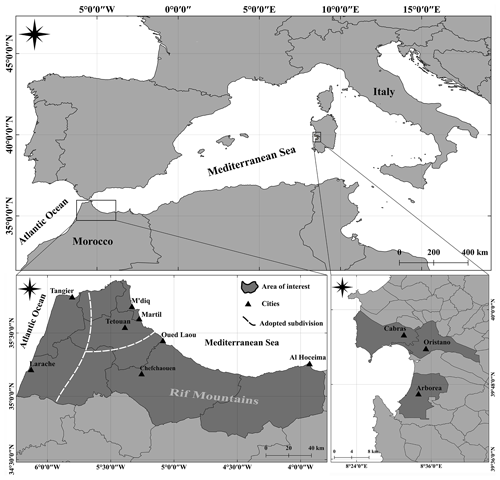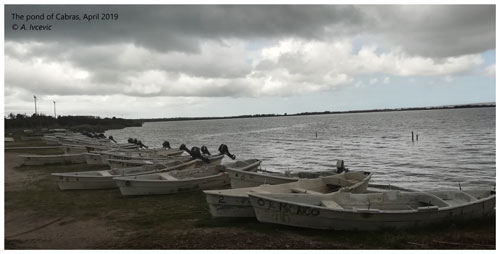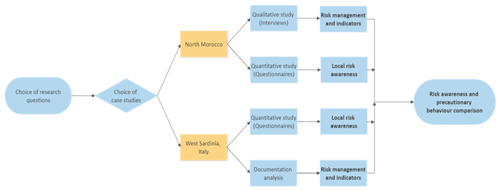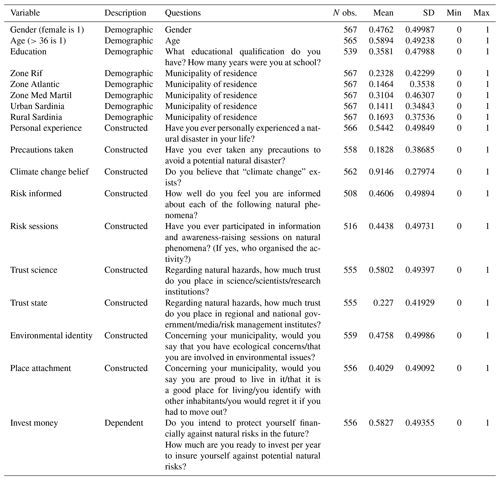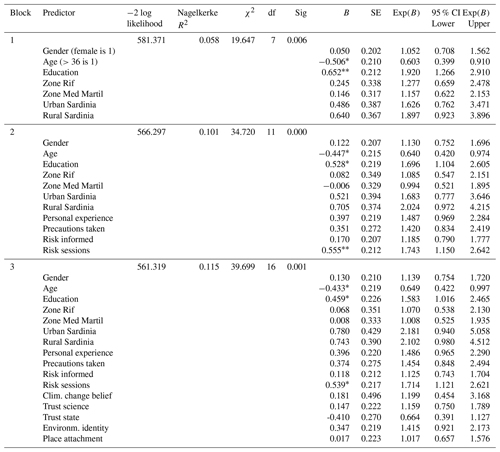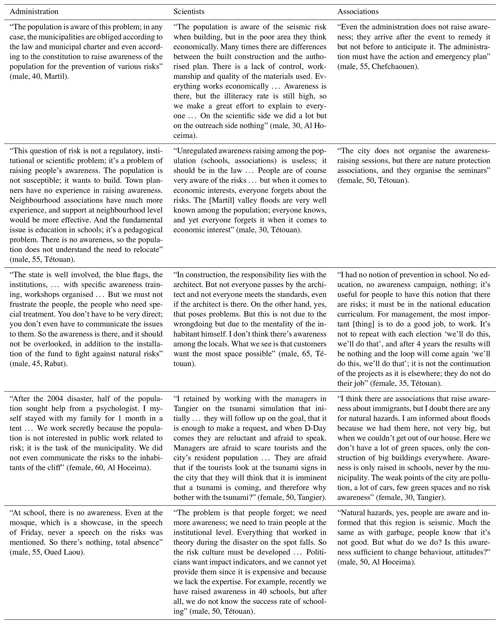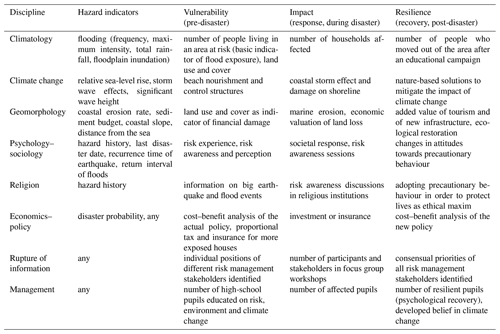the Creative Commons Attribution 4.0 License.
the Creative Commons Attribution 4.0 License.
Lessons learned about the importance of raising risk awareness in the Mediterranean region (north Morocco and west Sardinia, Italy)
Ante Ivčević
Hubert Mazurek
Lionel Siame
Raquel Bertoldo
Vania Statzu
Kamal Agharroud
Isabel Estrela Rego
Nibedita Mukherjee
Olivier Bellier
In order to mitigate the potentially dramatic effects of natural hazards, risk management measures are critical. However, the lack of interdisciplinary indicators and adaptable governance frameworks highlights society's vulnerability in the particular context of global environmental and climate change. This interdisciplinary research aimed at identifying reliable risk indicators and societal responses regarding natural hazards and climate change impacts to provide a governance framework for disaster risk reduction. Different societies face diverse risks and do not necessarily have the same level of local awareness of these risk. To explore the diversity of risks, two sites were selected from the Mediterranean basin, one chosen from the south coast (north Morocco) and the other from the north coast (the Italian island of Sardinia). North Morocco, a region of multi-risks, is characterised by high demographic and economic pressures; west Sardinia has remarkable biodiversity of wetlands and is characterised by high environmental and agricultural pressures, which in both cases intensify the vulnerability of the coastal areas. Testing for the local population's preparedness for future financial protection allowed for discussing the importance of risk awareness sessions or activities as an indicator of risk management. The significance of risk awareness sessions is shown in a quantitative part of the study, and its importance is also discussed with local stakeholders in north Morocco in a qualitative part of the study. It is shown that, although risk awareness sessions are recognised as important in risk management, they are not necessarily implemented. Based on these findings, further ideas on a new series of less descriptive, more dynamic and more user-friendly indicators are suggested. How can risk sessions be a dynamic indicator of a resilient society? The obtained results could serve in future governance frameworks for the mitigation of natural hazards in the Mediterranean region and more widely. Finally, the urgent need for continuous work to overcome the communication gap between the scientific community, risk administrators, civil society and the general population is emphasised.
- Article
(5751 KB) - Full-text XML
-
Supplement
(1586 KB) - BibTeX
- EndNote
Different societies living in a similar environment may face the same natural hazards but do not necessarily have the same level of risk awareness, which is defined as a representation of risk knowledge uptake by the local population. They do not share a common conceptual understanding of that risk, which is reflected by risk perception (Slovic et al., 1976). Actually, the vulnerability of societies is a dynamic process; is always relative to a certain situation; and depends on local knowledge, practices and cultural specificities. The importance of local knowledge for sustainable disaster risk reduction and management is largely recognised by international policy, such as the Sendai Framework for Disaster Risk Reduction (UN, 2015) and other international policies dealing with climate adaptation (Šakić Trogrlić et al., 2021). The questions of values (Zinn, 2009) and cultural and socio-economic background (Joffe, 1999; Joffe et al., 2013) are key societal problems when dealing with risks. Risk awareness and perception result in certain precautionary behaviours, which show their relevance for risk management. However, the extent to which local knowledge is translated into concrete, effective and practical measures is still open to debate.
A leading role in efficient risk management is played by risk perception, a concept that is already widely recognised in risk literature but with remaining open questions. In one of the first contributions of cognitive psychology to decision-making under risk, the concept of risk perception depicted that non-expert people might perceive risks by resorting to different logics than experts do (Slovic et al., 1976), making the process of risk appropriation more complex. Likewise, Covello (1983) suggested that a better understanding of how experts and non-experts reflect on and decide about risks would be beneficial to both risk analysts and decision-makers. In a later article, “Perception of risk”, Slovic (1987) proposed a strategy for studying perceived risk through a psychometric paradigm, which uses multivariate analysis techniques and scaling to produce a quantitative representation of risk perception. The main conclusion is that laypeople can be short of some information related to hazards but have a rich perception of risk that has to be included in risk assessments by experts. Rohrmann (1998) defined risk perception as a concept that “refers to people's judgements and evaluations of hazards” which are the “interpretations of the world, based on experiences and/or beliefs”. Since the images of risk are sometimes distorted, public perception is at least partly driven by biases, false assumptions and sensation, as argued by Renn (1998). He reasoned that risk perception studies help to collect different personal experiences with risks and to identify public concerns. However, they cannot state any normative legitimacy. Since scientific expertise and rational decision-making are necessary but not sufficient, such a debate between experts and non-experts is needed. Another discipline that has a say in risk perception is applied social psychology. As argued by Langford (2002), social and cultural settings need to be studied to determine how anxieties relate to the ways people perceive risks. Among his case studies, one related to climate change captured a wide range of personal, social and environmental anxieties. This helped him to argue that the complexity and importance that risk perception has in forming identities demand people's recognition and involvement. People need to be persuaded in their need to act, and only by believing in change can risk managers develop significant and far-reaching risk strategies.
However, when determining indicators in risk management, risk awareness, perception and behaviour need to be distinguished. Although sometimes the concepts of risk awareness and risk perception are overlapping (AlQahtany and Abubakar, 2020), with awareness at times considered to be just one of the components to measure risk perception (Khan et al., 2020), the concepts in this paper draw from the distinction made by Papagiannaki et al. (2019a, b). Risk awareness is, therefore, considered the measure of information and knowledge uptake. Risk perception is related to conceptual understanding of the threat, based on a personal interpretation of the knowledge arising from a cultural background, and risk precautionary behaviour is the result of awareness and perception based on the socio-economic context. Papagiannaki et al. (2019a, b) thus consider that risk awareness is a less technical concept than risk perception. A recent study on hydrogeological risk awareness and preparedness in Italy (Mondino et al., 2020) concluded that a lack of big events and poor risk communication strategies can cause risk awareness to decrease. This shows that risk awareness is essential for adequate risk management policies and needs to be further explored. Moreover, since risk questions are always societal problems and relate to values (Zinn, 2009), the cultural context needs to be tested.
Inspired by a cultural approach that considers risk a social and cultural construct (Bertoldo, 2021), this study will compare two different societies with different socio-economic contexts. The focus will be on the indicator of risk awareness and its impact on precautionary behaviour in order to understand the practical drivers for taking measures. The main questions we therefore ask in this paper are as follows: are locally organised activities dedicated to increasing risk awareness able to serve as a predictor of societal resilience to face risks? More precisely, are the participants in risk sessions associated with higher risk awareness and do they opt more for precautionary behaviour? This comparative quantitative and qualitative study contributes to explaining risk preparedness by comparing the role that risk awareness sessions have for all stakeholders included in risk management processes. It describes relations between risk awareness and precautionary behaviour in two areas chosen from the Mediterranean basin. It also explores the role of risk awareness sessions in explaining the precautionary behaviour of investing money for protection measures. Finally, it discusses the additional benefits that risk awareness sessions can have when constructing dynamic indicators of risk management.
2.1 The study sites
More than 500 million people are estimated to currently live in the countries bordering the Mediterranean Sea (Karadirek et al., 2019), with around 150 million people living along the Mediterranean coasts (Cramer et al., 2018). The Mediterranean basin is one of the cradles of civilisation and has always been an attractive migration hub; nowadays it is also the most visited tourist destination in the world with more than 330 million visitors in 2016 (Tovar-Sánchez et al., 2019). This region is prone to many natural hazards (Satta et al., 2016) and, due to a very dense population, is a vulnerability hotspot. The International Panel on Climate Change (IPCC) identified the region as one of the regions most vulnerable to global warming, forecasting a temperature rise of 2–3 ∘C by 2050, which makes it a climate change “hotspot” (Plan Bleu, 2019). The region is projected to experience the highest increase in the frequency of occurrence of extreme weather events due to climate and environmental change (Vousdoukas et al., 2017), and the open question is whether the population is aware of those imminent risks. The chosen field cases from the Mediterranean basin are north Morocco and west Sardinia (Fig. 1).
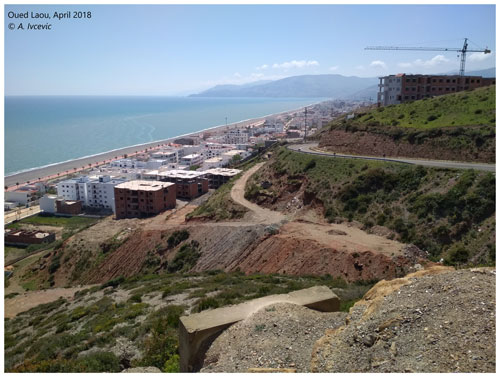
Figure 2The region of north Morocco, which has experienced a high increase in touristic infrastructure.
The region of north Morocco is a multi-risk zone, which is worth studying due to the increased complexity of social and natural processes. The region is prone to natural hazards particularly due to the seismic activity in the Gibraltar–Alboran region, between the Nubian and Iberian plates, that hosted disastrous earthquakes like the 1755 Lisbon and 2004 Al Hoceima events (Neres et al., 2016). In addition, due to natural predispositions (lithology and slopes) and land use of the Rif mountains, as well as the location on the transition between different climate types, the area frequently suffers from landslides, erosion, droughts, floods and flash floods (Ivčević et al., 2020). The region's coasts are also characterised by a decreased resilience to climate change due to the heavy urbanisation of the coastline (Snoussi et al., 2010), which is highly exposed to sea-level rise (Satta et al., 2016) and possibly tsunamis (Benchekroun et al., 2015). During the last few decades, the vulnerability of the region has increased since it became an economic hub at the end of the 20th century, with a touristic infrastructure boom (Fig. 2) and the project of the Tanger Med harbour. Nevertheless, Morocco maintains, in its modernity, very strong traditional components, with traditional forms of use of space (El Abdellaoui et al., 2008). The population lives off the land, and the agricultural sector is the backbone of the regional economy (Salhi et al., 2020). Besides, Morocco is a Muslim society, with religion having a significant influence on opinions and perceptions of risk, particularly seismic ones (Paradise, 2008).
The coasts of west Sardinia belong to the one-third of the Mediterranean basin most exposed to natural hazards, mostly due to very high wave heights (Satta et al., 2017). The area of the Gulf of Oristano is frequently hit by extreme weather events, above all flash floods and coastal storms, predominantly during the cold season. Also, a maximum relative sea level for the Gulf of Oristano and the year 2100 is expected to reach up to 949 based on the IPCC AR5 RCP8.5 scenario, which could leave some parts of the gulf partially flooded (Antonioli et al., 2017). Regarding flooding, wetlands in this area (Fig. 3) play a vital role in disaster risk reduction, but they also create a conflict between urban, fishing and farming activities, with the famous fishing town of Cabras and the fertile area of Arborea, home to extensive agricultural production. In addition, Sardinians have a long tradition of autonomous governance and environmental awareness, which even included wildfire regulations in the 14th century (Ivčević et al., 2021).
In this study, north Morocco and west Sardinia are compared in order to explore what could contribute to increased risk awareness and precautionary behaviour of the local population. These two studies provide the opportunity to compare how participating in risk awareness sessions is translated into practice. A face-to-face questionnaire-based survey was organised with respondents sampled among the general population using the same set of topics but adapting them to the regions' particularities. In addition, interviews were held with the main stakeholders in north Morocco and policy documents were analysed for the Sardinia case study to confirm or reject the importance of risk awareness sessions as part of actual risk management in the two regions. In the quantitative part of the study, a binary logistic regression model was used to model the willingness of respondents to invest money in protective measures. The qualitative part of the study represents an additional source of information to be combined with the responses from the questionnaires. This is important to understand the advantages and flaws of the present risk policy and to overcome a possible risk management gap. Analysing what these two different field studies teach us about the wider multicultural Mediterranean region sustains a deeper reflection about how these common challenges contribute to risk management strategy in other locations from the region. Potential policy advice related to multi-risks and risks related to climate change is formulated, which could contribute to disaster risk reduction in light of the UN Sendai recommendations, preventing future human and financial loss.
2.2 Participants and fieldwork procedure
A flow chart explaining the steps of the methodology adopted is presented in Fig. 4. The fieldwork procedure was both quantitative and qualitative, organised around questionnaires and interviews. Firstly, to gain an answer to the usefulness of risk awareness sessions, questionnaires and interviews were used for the Moroccan case study. The questionnaire for the general public resulted in responses of 391 inhabitants of the region of north Morocco from eight different communes, who responded in a public setting during November 2018. The chosen municipalities belong to areas with different historical hazard records and different geographical characteristics and are divided into three areas for the purpose of this study: the Atlantic coast (Tangier, Larache), valley of the river Martil (Tétouan, Martil, M'Diq) and Rif mountain zones (Al Hoceima, Chefchaouen, Oued Laou) (Fig. 1). The obtained sample is composed of 44.2 % female respondents and thus under-represents the female population (which is represented on the regional level by 49.27 %, 2014 census – Haut-commissariat au Plan, 2018). The respondents are on average between 36 and 41 years old (the sample skews older based on the fact that Morocco is a young nation with a median age of 29.5 years, 2014 census).
In the Sardinian case study, the questionnaires were used for data collection, which were later combined with the existing secondary literature on risk management on a national and regional level. In the area of west Sardinia, 176 inhabitants from three different municipalities, the urban Oristano and rural Cabras and Arborea, responded to our questionnaire in a public setting. This questionnaire-based survey was conducted during May and June 2019. Data were collected face to face, by targeting the general population, and about 20 min was needed to complete each survey. The Sardinian sample is composed of 45 % male respondents (the male population comprises 49 % of the total in the 2011 census (Istat, 2013), so our sample under-represents the male population). The average participant is 46.4 years old (44 is the average age of the population, 2011 census).
Secondly, the use of interviews in the north Moroccan study was two-fold: they served to introduce the problem of risk management in the region and to construct the questionnaire. Regarding the Sardinian case study, the secondary literature on risk management at the regional and national level was analysed.
2.3 Quantitative part of the study – survey content, variables and analysis
The Moroccan and Sardinian questionnaires consisted of 39 and 30 questions, respectively, and were divided into five sections. Not all questions from the questionnaires were used in this analysis. The common parts of the questionnaire were the sections that dealt with risk awareness, personal experience, and formal and informal education on risks, in addition to questions regarding institutional trust, environmental identity and place attachment and finally questions about the belief in climate change, adopting precautionary measures and investing money. It is of note that no risk awareness sessions were organised in the local community; only the previous experience of respondents regarding risk sessions was registered. Those questions were closed-ended (dichotomous and Likert rating scale). The full questionnaires (in French and Italian) are available as supplementary material. The data were described in Excel and SPSS, the latter being used for factor analysis and the regression model. The regression model used was binary logistic, which allows for dividing variables into more blocks, tracking the model's progress. All the variables were nominal (Table 1).
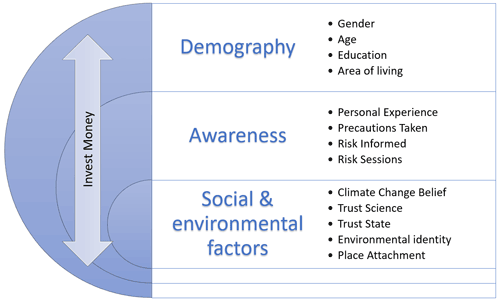
Figure 5Schematic presentation of the binary logistic model describing willingness to invest money in disaster risk reduction, with dependent variable of investing money.
The first set of variables used in the regression model consists of demographic ones: gender (value 1 for women), age (value 1 for those respondents older than the mean age of 36 years old), education (value 1 for those with a bachelor's degree or higher) and zone of living (Morocco – Atlantic, Martil, Rif; Sardinia – urban and rural; five dummies for five zones). The second block includes variables related to risk awareness that are considered to describe better future willingness to invest money as an indicator of precautionary behaviour. Risk awareness was described using questions related to the level of information about natural hazards, i.e. how much the respondents considered themselves informed about natural hazards in their region (each hazard was listed and evaluated on the Likert 1–5 scale), rating their level of information about natural hazards (drought, flood, landslide, coastal storm, sea-level rise, heatwave, earthquake, coastal erosion and wildfire) and about climate change and whether or not they participated in the awareness sessions or environmental education campaigns organised by the municipalities or associations (e.g. Domingues et al., 2018; Ivčević et al., 2020). The first study was the north Moroccan one, in which the variables were explored and constructed and the reliability was tested. Items were submitted to a factor analysis (Kaiser–Meyer–Olkin measure of sampling adequacy was 0.897; Bartlett's test of sphericity was χ2 = 1679, with df = 55 and p < 0.001). The factors retained were “risk informed” (α = 0.890) and “risk sessions” (α = 0.381), which are used in the following analysis. Besides, the variable of personal experience of a natural hazard (yes/no) was added, whose importance in risk perception has been shown in similar studies (e.g. Papagiannaki et al., 2019b). Next, the respondent's belief in the existence of climate change was asked (yes/no). Moreover, the respondents were asked if they had previously taken any precautionary measures (yes/no). The final block of variables, related to trust, environmental identity and place attachment, was to test the supplementary variables for their impact on future precautionary behaviour. The place attachment was measured using items such as “I think this municipality offers a good living environment” and represents a relationship of the resident with their municipality (Bonaiuto et al., 2016). These items were averaged to a single variable with a satisfactory consistency (α = 0.827). The environmental identity was measured using items such as “I think of myself as someone engaged in environmental issues” and represents environmental concerns of residents (Bertoldo and Castro, 2016), averaged into a single variable with good consistency (α = 0.846). Social trust, regarding science and institutions involved in risk management, is of importance especially when respondents cannot manage risks on their own (Achterberg et al., 2017). The items were submitted to a factor analysis (Kaiser–Meyer–Olkin measure of sampling adequacy was 0.768; Bartlett's test of sphericity was χ2 = 1230, with df = 21 and p < 0.001) which split them into two dimensions: trust in science (α = 0.887) and trust in state (α = 0.804). The variables were constructed based on the Moroccan case study and were implemented in a similar way to the collection of the Sardinian data set. Later, all those items were measured using a 5-point Likert scale and then dichotomised: participants with responses above the mean were considered to have a high value and those under the mean to have a low value, and the responses are as such used in a binary logistic model, schematically presented in Fig. 5. For more details on the variables chosen, refer to publications by Ivčević et al. (2020, 2021).
2.4 Qualitative part of the study – interviews and secondary literature
In north Morocco, the interviews were based on an interview guide, which consisted of five main parts. The general topic was the influence of the representation that associations, administrators and scientists has on the relationship between citizens and risk and on the influence of memory and the territorial context in the development of management tools, particularly preventive communication. Firstly, the life in the region and the relationship and attachment the respondent has with the place of living were discussed. Then, knowledge and history of risk phenomena in the region were questioned, followed by questions regarding personal experience and risk memory. Here the interlocutors were asked about the different types of knowledge (scientific and vernacular) that the institutional practices base their risk awareness activities on when talking about risks to the general population. Thirdly, the level of information provided and prevention and risk management in the region, as well as the importance of risk awareness sessions in risk management strategies, were debated, followed by a consideration of the region within the context of national and international risk policies. Finally, the meaning and use of indicators in risk management were debated. There were 25 interviews conducted, and the interviewees were grouped into three categories: (a) the elected or appointed administrators (8 interviews); (b) the scientists and technicians that work in the risk research or management (8 interviews); and (c) the members of civil society, i.e. associations (9 interviews). All 25 narratives were recorded and transcribed, and basic discourse analysis was carried out using the software Iramuteq (Ivčević, 2020). The main parts of the interview guide and the groups interviewed are presented in Table 2. As far as the Sardinian case study is concerned, the secondary literature on risk management at the regional (Sardinia) and national (Italy) level was obtained as public documents available freely from administrative web pages. These sources served to contrast the population's responses with the official directions in managing natural risks. Since this literature was easily accessible, a qualitative study in the form of interviews with the local authorities was not considered to be essential for this research, conversely to the Moroccan case study.
3.1 Quantitative – explaining future willingness to invest money based on actual risk awareness
Willingness to invest money in order to protect from future natural hazards was examined through a binary logistic model. Willingness was regressed on three blocks of variables. The first block included demographic variables of gender, age, education and zone of study. The second block included risk awareness variables that were considered to contribute more to explaining future willingness to invest: personal experience, precautions taken, risk informed and risk sessions. The last block included additional variables that hopefully could help clarify which profiles are open to risk investing: trust in science and state, environmental identity, place attachment, and belief in climate change. Presented in Table 3, the results show that demographic variables that significantly predict future willingness to invest money in protection are the age of the sample being over 36 years old (−0.433, p < 0.05) and the education level of any university degree (0.459, p < 0.05). This result suggests that being under 36 years old and having a university education is positively associated with monetary investments for natural risk protection. The only additional indicator that predicts future willingness to invest is the awareness indicator of following risk sessions (0.539, p < 0.05). Personal experience is a marginally significant positive predictor (0.396, p < 0.1), as well as the fact of living in west Sardinia – in both urban areas (0.780, p < 0.1) and rural areas (0.743, p < 0.1). None of the indicators introduced in the third block significantly contributed to future willingness to invest money. The model overall describes over 11 % of the social variability in the sampled population (Nagelkerke R2 = 0.115).
3.2 Qualitative – the importance of the risk awareness sessions according to the stakeholders
The interviewees were asked about natural hazards, their memory of catastrophic events and the risk management policy in the region. Among the useful information given, some particular answers need to be discussed. During these interviews, among the main topics debated, risk awareness sessions were the hot subject argued about. The verbatim extracts of these results are presented in Table 4.
As far as risk awareness and risk sessions are concerned, the administration in some cities (male, 45, Rabat; male, 40, Martil) claims that the sessions are present and organised and that the population is aware of risk. However, those from smaller municipalities agree that the population is somewhat aware of risks, but they do not agree that there are risk awareness sessions (male, 55, Oued Laou; female, 60, Al Hoceima). The administration even admits that sometimes talking about risks is omitted on purpose (male, 45, Rabat; female, 60, Al Hoceima) but also thinks that the associations know better than they themselves do how to raise awareness (male, 55, Tétouan).
The scientists are more critical. They agree that discourse on risks can be intentionally left aside (female, 50, Tangier), and they can agree that the population is aware of local risks but is more money-driven and makes decisions based on economics (male, 65, Tétouan; male, 30, Al Hoceima; male, 50, Tétouan). The scientists agree that more risk awareness is needed but that the outreach campaigns need to be regulated (male, 30, Tétouan). The scientists also admitted that, when undertaking risk awareness sessions in schools, they lack the expertise or means to address what to do later with those data (male, 50, Tétouan).
However, regarding risk awareness, the civil society expects more from the administration. Whether there is some awareness at schools (female, 30, Tangier) or not (female, 35, Tétouan), more awareness and prevention are expected from the municipalities (male, 55, Chefchaouen; female, 30, Tangier). If the municipality does not raise awareness, there are luckily some associations that fill in that gap (female, 50, Tétouan), but the questions posed are how does the awareness translate into a behaviour and is the awareness sufficient to change attitudes regarding natural hazards (male, 50, Al Hoceima)?
As far as the Sardinian case study is concerned, risk awareness sessions among the local society experiencing and managing risks seem to be taken into consideration in the official documents but in a form of a theoretical wish list. In “Elements for a National Strategy of Adaptation to Climate Change” (Castellari et al., 2014), the authors recognised the importance of risk perception: “investments in innovative monitoring technologies, investments to improve communication and to raise awareness of perception and risk management by citizens (an informed population is more aware and safer), they are priority measures of `non-structural' adaptation in the context of climate change” (p. 38) and “effective communication, awareness and information activity involving the interested parties for the purpose is, therefore, essential to ensure an adequate perception of these risks” (p. 216).
Similarly, in the Sardinian “Regional Strategy of Adaptation to Climate Change” (adopted in 2019), among the general criteria in developing the objectives is the “awareness and education on climate change, to ensure full awareness of the future risks associated with expected climate pressures and to stimulate responses also oriented towards the development of bottom-up planning tailored to specific local needs” (p. 37). This document is followed by an extensive and detailed “Methods and Tools for the Regional Strategy of Adaptation to Climate Change” (Zinzula et al., 2018), where indicators useful for knowledge of the state of the environment in Sardinia are listed; among them the farmers' perception of the threats related to climate change is elaborated. In addition, the document “Guidelines for Regional Adaptation Strategies” elaborates the role of the coordination group and dedicates a place to questionnaires and workshops in the process of adaptation: “developing specific surveys with questionnaires or semi-structured interviews, focus groups, participatory workshops, laboratories managed with methodologies relating to participatory planning, etc.” (Cocco et al., 2019). Finally, a document “Guidelines, Standardised Principles and Procedures for Climate Analysis and the Assessment of Vulnerability at Regional Level”, from the same MASTER ADAPT project (Giordano et al., 2019), calls for the quality of input data and states that a “deeper understanding of how a sector/system/territory behaves with respect to climate changes contributes, in fact, to establishing adaptation objectives and targets, to providing the necessary elements for planning adaptation measures, to raising community awareness, and to monitoring and evaluating adaptation policies” (p. 31).
4.1 All stakeholders underline the importance of risk awareness sessions, but is this only wishful thinking?
The results from quantitative case studies in north Morocco and Sardinia, targeting the general population, indicate that participation in risk sessions seems to have an impact on precautionary behaviour, related to future willingness to invest money in order to protect (Table 3). The importance of risk awareness sessions is also confirmed by interviews in the qualitative study in north Morocco. Although both scientists and members of associations call for more awareness campaigns, the majority of administrators defend the position that the population is already aware of risks and that the institutions are well-involved. Still, an administrator from a smaller municipality admitted the absence of sessions and learning processes regarding risk. The risk awareness sessions in risk management are elaborated by all three groups of interlocutors. As stated by the administrators in Rabat, Martil and Al Hoceima, the risk sessions exist and the population is aware of the risks, but in Oued Laou and Tétouan they do not agree, showing the local differences within the region.
On the national level, the Moroccan state is well-included in risk management and international policies, as confirmed by an administrator from Rabat. Besides, the Moroccan “Référentiel de l'Urbanisme Durable”1 (2017) elaborated the detailed commitment in which Morocco engaged by adopting the New Urban Agenda from Habitat III in Quito in October 2016. The fifth issue, dedicated to “Health and Citizens' Security”, includes a special theme on “Management of Natural and Technological Risks”, with natural hazards like avalanches, wildfires, floods, landslides, cyclones, storms, earthquakes and volcanic eruptions. The listed objectives of prevention are as follows: to suppress the extent of the hazard, to control its effects, and to reduce the exposure of people and goods. The strategy of implementation is rather ambitious, with action, intervention, urgency and rescue plans, followed by financial investments to implement alerting systems, to develop risk cartography, to ensure constructions conform with earthquake-resistant standards, to integrate risk management into local action plans and to realise infrastructure resilient to risks.
However, there is a void that is proposed by the interlocutors, starting from a lack of legal respect and including a lack of awareness and trust. Firstly, although the state's impact on a national level was acknowledged by the administrators and the laws are there, these laws are not respected, as stated by the scientists. The population seems to disobey the legislation, as well as the local leaders, when it comes to financial matters, which creates distrust. Is the local population aware of risks, or does it just make decisions based on economic opportunity? It could be considered that awareness and financial means are actually intertwined. Financial resources are also likely to influence the risk management that is deficient at the municipal level. The smaller municipalities of Oued Laou and M'Diq do not use indicators of risk management; therefore they do not manage risks on their own.
Secondly, a remarkable obstacle in advanced risk awareness campaigns is the reciprocal mistrust between administrators and scientists. Distrust regarding awareness and prevention sessions of local leaders towards scientists is confirmed by the researcher working in the national research institute CNRST2 in Rabat. While conducting her research on tsunami hazard in Tangier she was refused to do the evacuation exercise on tsunamis and to place tsunami signs in the city.
The distrust between the administration and the broad population is mutual, as well. A female member of the association from Tétouan judged the administrative, repetitive discourse of making commitments before each election but not fulfilling any later on, and a female administrator admitted not even communicating the risk to the inhabitants of the cliff in Al Hoceima.
As far as the Sardinian case study is concerned, all official documents look professional and detailed but without concrete measures for a broad assessment of risk awareness. Based on the results from the quantitative case study, the indicator of risk awareness sessions seems to be significant in deciding whether or not the local population invests in future protection. Besides, the lack of risk awareness sessions was often brought out by the respondents on the margins of the quantitative study. However, actual activities might in fact exist. The impression is that these strategic documents recognise the need for awareness and education sessions but do not indicate specific training activities. It is as if there is no follow-up of these wishes in concrete monitoring; therefore the documents do not provide a useful indicator of climate change adaptation. This calls for the administration to promote more risk awareness sessions among the general population. As argued, among other criteria that contribute to taking precautionary behaviour are the economic criteria. However, risk awareness sessions will certainly contribute to some future risk decisions the inhabitants make. To sum up this discussion, a point stated by a male member of the association from Al Hoceima can be used to depict the awareness situation: “Natural hazards, yes, people are aware and informed that this region is seismic. Much the same as with garbage, people know that it's not good. But what do we do? Is this awareness sufficient to change behaviour, attitudes?”
4.2 Future perspectives of the results as an input for risk policy – the importance of dynamic indicators
Another recommendation of this study regards dynamic indicators in risk management. Although the content of the past risk awareness sessions was not analysed within this study, risk awareness sessions seem to be considered useful in preparedness and risk management strategy by the participants of these research activities. As such, they could be imagined as an effective risk management tool, and their true utility should be tested to confirm the effectiveness of risk awareness sessions in adopting precautionary behaviour. In efficient risk management, indicators should be used to collect information on every phase of the disaster management cycle, building a less vulnerable society. For example, in economics, cost–benefit analysis of the actual and new risk policy, before and after the investment, could be coupled. Also in education, for instance, the number of middle- or high-school pupils educated on risk and climate change could be coupled with the number of resilient pupils in an affected area and those that consequently developed a belief in climate change processes, which was shown to have an impact on the Sardinian population in adopting precautionary behaviour. Raising awareness in schools was already being carried out in Tétouan, as brought out by our interlocutor, but so far without a success rate estimate (male scientist, 50, Tétouan).
Information on hazard history, the recurrence time of earthquakes or the return interval of floods can be used as input data for risk awareness sessions that would boost both awareness and perception and provoke changes in attitudes towards precautionary behaviour, as was shown in north Morocco. Risk awareness sessions could be followed up on a certain timescale, and that can further contribute to the interdisciplinarity of risk science with policy, psychology and economics. Furthermore, the north Moroccan example showed the need for integrating risk awareness sessions with religious institutions. The hazard history of great earthquakes and floods could be used as input risk information during religious discussions with an outcome of an ethical maxim of adopting precautionary behaviour to save human lives. Moreover, the participatory approach is always important for a successful information flux between all stakeholders included in risk management processes. It can also be assessed dynamically, by initially identifying the individual positions of the risk management stakeholders and consequently reaching consensual priorities of all stakeholders after participatory focus groups.
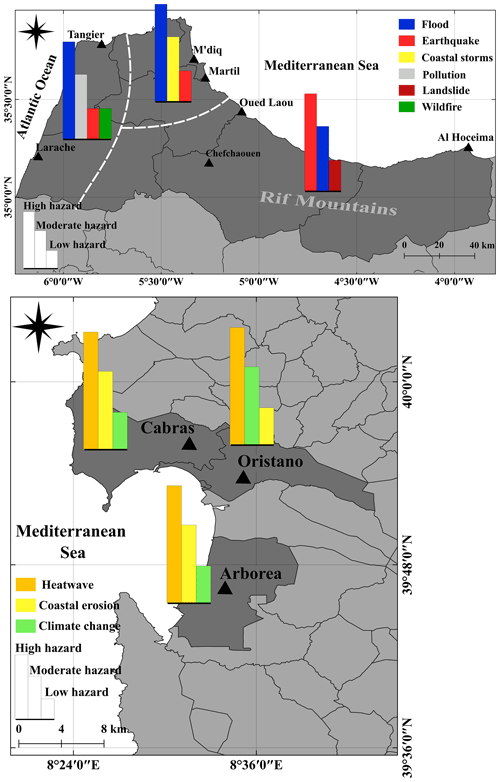
Figure 6Differences in main hazards perceived in north Morocco and west Sardinia by the general population.
This way of approaching indicators is a suitable consideration for different hazard types. Flood hazard and the number of people living in the area exposed to flood would be an example of a vulnerability indicator. Since it could be assumed that we have the information about flood frequency and maximum or average intensity, an educational campaign in that area could be organised. The number of people that moved out of that flooded area based on the input of the educational campaign, in some limited time frame, could be measured and be considered a resilience indicator. These pieces of information could indicate not only the success of the flood awareness campaign but also the local readiness to cope with the ongoing change. Last but not least, if we consider sea-level rise and coastal storm effects a consequence of climate change, the community can be informed about the annual cost of beach nourishment and possible control structures. If the coastal storm damage is registered and the benefits of nature-based solutions to mitigate the impact of climate change are divulged to the population, it could be that the community would see the utility and financial benefit of nature-based solutions, as is promoted in the case of wetlands from the Sardinian case study. A similar idea can be used for the example from geomorphology. These ideas are presented in Table 5 and are some of the possible changes that dynamic indicators could bring to the community. Finally, organising a series of risk awareness sessions in the local community, open to and aimed at all stakeholders, would certainly represent an instructive research activity that would contribute to clarifying the existing learning processes between the local stakeholders and improving risk management.
4.3 Limits of this study
A main contribution of the two Mediterranean case studies analysed is the region's north–south coupling and comparison, where Morocco and Italy could easily serve as pilot studies to other countries, sharing the methodology and adapting to local physical and social particularities. Likewise, undertaking risk perception case studies in lower-income countries could help us to avoid the mindset of higher-income countries, with financial obstacles playing a role in different forms of precautionary behaviour. The variety of case studies should increase the efficiency of risk management strategies. Still, comparing two areas of study is not always a simple task: risks are complex phenomena, and those acceptable in one cultural context are not necessarily acceptable in another (Dauphiné, 2003). In this case, the first aspect to keep in mind while trying to compare these two Mediterranean territories was their relative size. North Morocco is a region of more than 17 000 km2 with more than 3.5 million inhabitants. The Sardinian surface is a little over 24 000 km2 with 1.6 million inhabitants. However, the Gulf of Oristano municipalities included in our Sardinian case study comprise a surface area that is 17 times smaller than that of the Moroccan case study, with 40-times-fewer dwellers (1000 km2, 85 000 people). This is the biggest limit of this comparative study. Another important remark regards the difference in hazard history that these areas have experienced. Inhabitants of the Rif have a recent series of earthquakes in living memory, with a notorious and deadly event in 2004. Conversely, Sardinians seem to be less impacted by what they have experienced and learned regarding their territory. These differences in risk experience may lead to differences in the main hazards perceived between the two studied regions (Fig. 6). To continue, additional comparative studies from the Mediterranean basin should be organised, from both northern and southern coasts. Those studies would generate new knowledge that should be constantly shared in the form of risk awareness sessions, improving the information transfer between different interlocutors and local dwellers that are, although diverse, not so different in the end.
Hazards occur regardless of the situation, whereas vulnerability is a dynamic process, always relative to a certain situation. Local knowledge, practices and cultural particularities between countries should be acknowledged, respecting the local scale for every unique case and questioning risk perception. The theory of common sense helps to clarify the importance of local knowledge, keeping it from fading into oblivion. The results from two Mediterranean case studies, north Morocco and west Sardinia, confirm the importance of interdisciplinarity in risk management since hazard history and environmental conditions, as well as societal and cultural characteristics, contribute to increased risk awareness and precautionary behaviour of the local population. These two case studies have shown the importance of risk awareness sessions to financial precautionary behaviour. The general population seems to believe that “risk awareness sessions” are an adequate indicator of local resilience. This information should be useful for policymakers at regional and national levels. Unfortunately, the policy literature and interviews held with the administrators and scientists indicate that although recognised, the importance of risk awareness sessions is not necessarily put into practice. As a consequence, this could lead to a failure of risk management policy. Although there is constant improvement in risk management policy, with the Sendai Framework and the increase in the participatory approach and local perception studies, the question is how to make a step forward. The communication gap is one of the problems, where the language used is not suitable for different groups of society included in risk management. To overcome this gap, more dialogue between different stakeholders included in the risk management process is needed. The dire need for continuous transdisciplinary work to overcome the communication gap between the scientific community, risk administrators and the general population is encouraged. The technical documents can be well done, but the information should be transmitted clearly, popularised and even vulgarised for the general population, going door to door in risk areas if needed. Last but not least, risk awareness sessions have a crucial position in learning processes and in the usage of dynamic indicators. They can be followed on a timescale, and that can further accompany the transdisciplinarity of risk management.
The data set and software code are available at https://doi.org/10.17605/OSF.IO/GMKYQ (Ivčević, 2021).
The supplement related to this article is available online at: https://doi.org/10.5194/nhess-21-3749-2021-supplement.
The research presented in the current publication was designed and coordinated by AI, HM, LS and RB. The lead author, AI, designed the questionnaire, processed the data set and drew conclusions. RB, VS, NM and IER provided statistical expertise for data analysis and methodologies used in social science. LS, KA and OB provided expertise for the integration of geoscience within this interdisciplinary research.
The contact author has declared that neither they nor their co-author has any competing interests.
Publisher's note: Copernicus Publications remains neutral with regard to jurisdictional claims in published maps and institutional affiliations.
The authors are thankful for financial support received and are grateful to the local populations and other local stakeholders that provided useful information for this study. Also, the authors are thankful to the two reviewers, whose comments helped to improve the manuscript. Finally, the first author is particularly thankful to Matthieu Kervyn from Vrije Universiteit Brussel and to Marta Banožić from the University of Vienna for their advice on, reading of, editing of and commenting on the manuscript.
This research has been supported by the H2020 Marie Skłodowska-Curie Actions (grant no. 713750), the Regional Council of Provence–Alpes–Côte d’Azur and the Agence Nationale de la Recherche (grant nos. ANR-11-IDEX-0001-02, ANR-11-LABE-0061 and ANR-1-1E-0001-02).
This paper was edited by Vassiliki Kotroni and reviewed by two anonymous referees.
Achterberg, P., De Koster, W., and Van der Waal, J.: A science confidence gap: Education, trust in scientific methods, and trust in scientific institutions in the United States, Public Underst. Sci., 26, 704–7202017, 2014.
AlQahtany, A. M. and Abubakar, I. R.: Public perception and attitudes to disaster risks in a coastal metropolis of Saudi Arabia, Int. J. Disast. Risk Re., 44, 101422, https://doi.org/10.1016/j.ijdrr.2019.101422, 2020.
Antonioli, F., Anzidei, M., Amorosi, A., Presti, V. L., Mastronuzzi, G., Deiana, G., De Falco, G., Fontana, A., Fontolan, G., Lisco, S., and Marsico, A.: Sea-level rise and potential drowning of the Italian coastal plains: Flooding risk scenarios for 2100, Quaternary Sci. Rev., 158, 29–43, 2017.
Benchekroun, S., Omira, R., Baptista, M. A., El Mouraouah, A., Brahim, A. I., and Toto, E. A.: Tsunami impact and vulnerability in the harbour area of Tangier, Morocco, Geomat. Nat. Haz. Risk, 6, 718–740, 2015.
Bertoldo, R.: A comparative frame for a contextualised analysis of local natural risk management, Int. J. Disast. Risk Re., 52, 101945, https://doi.org/10.1016/j.ijdrr.2020.101945, 2021.
Bertoldo, R. and Castro, P.: The outer influence inside us: Exploring the relation between social and personal norms, Resour. Conserv. Recy., 112, 45–53, 2016.
Bonaiuto, M., Alves, S., De Dominicis, S., and Petruccelli, I.: Place attachment and natural hazard risk: Research review and agenda, J. Environ. Psychol., 48, 33–53, 2016.
Castellari, S., Venturini, S., Giordano, F., Ballarin Denti, A., Bigano, A., Bindi, M., Bosello, F., Carrera, L., Chiriacò, M. V., Danovaro, R., and Desiato, F.: Elementi per una Strategia Nazionale di Adattamento ai Cambiamenti Climatici, Ministero dell'Ambiente e della Tutela del Territorio e del Mare, Roma, 245 p., 2014.
Cocco, G., Arras, F., Congiu, A., and Satta, G.: Linee Guida per le Strategie Regionali di Adattamento ai Cambiamenti Climatici, MASTER ADAPT, Roma, 97 p., 2019.
Covello, V. T.: The perception of technological risks: A literature review, Technol. Forecast. Soc., 23, 285–297, 1983.
Cramer, W., Guiot, J., Fader, M., Garrabou, J., Gattuso, J. P., Iglesias, A., Lange, M. A., Lionello, P., Llasat, M. C., Paz, S., and Peñuelas, J.: Climate change and interconnected risks to sustainable development in the Mediterranean, Nat. Clim. Change, 8, 972–980, 2018.
Dauphiné, A.: Risques et catastrophes. Observer, spatialiser, comprendre, gérer, Armand Colin, Paris, 288 p., 2003.
Domingues, R. B., Santos, M. C., de Jesus, S. N., and Ferreira, Ó.: How a coastal community looks at coastal hazards and risks in a vulnerable barrier island system (Faro Beach, southern Portugal), Ocean Coast. Manage., 157, 248–256, 2018.
El Abdellaoui, M., Chikhi, N. E., and Boulifa, A.: Agriculture et dynamiques territoriales dans la zone spéciale de développement économique “Tanger–Méditerranée”, Université Abdelmalek Essaâdi, Tétouan, 2008.
Giordano, F., Barbieri, L., Freixo Santos, T., Bono, L., Ballarin Denti, A., Lapi, M., Cozzi, L., Pregnolato, M., Oliveri, S., Marras, S., Maragno, D., Magni, F., Musco, F., Satta, G., Congiu, A., and Arras, F.: Linee Guida, Principi e Procedure Standardizzate per l'Analisi Climatica a la Valutazione della Vulnerabilità a Livello Regionale e Locale, MASTER ADAPT, Roma, 111 p., 2019.
Haut-commissariat au Plan: Données du Recensement général de la population et de l'habitat de 2014 – Niveau national, Rabat, 2018.
Istat: L'Italia del censimento: Struttura demografica e processo di rilevazione – Sardegna, Censimento generale della popolazione e delle abitazioni 2011, Roma, 2013.
Ivčević, A.: Indicators in risk management: a fresh perspective between hazard analyses and societies' responses, PhD dissertation, Aix-Marseille University, Marseille, France, 2020.
Ivčević, A.: Risk Awareness Morocco-Sardinia, OSF [code and data set], 9 October, https://doi.org/10.17605/OSF.IO/GMKYQ, 2021.
Ivčević, A., Bertoldo, R., Mazurek, H., Siame, L., Guignard, S., Ben Moussa, A., and Bellier, O.: Local risk awareness and precautionary behaviour in a multi-hazard region of North Morocco. Int. J. Disast. Risk Re., 0, 101724, https://doi.org/10.1016/j.ijdrr.2020.101724, 2020.
Ivčević, A., Statzu, V., Satta, A., and Bertoldo, R.: The future protection from the climate change-related hazards and the willingness to pay for home insurance in the coastal wetlands of West Sardinia, Italy, Int. J. Disast. Risk Re., 52, p.101956, https://doi.org/10.1016/j.ijdrr.2020.101956, 2021.
Joffe, H.: Risk and 'the Other', chapter 6 in: Social representations of risks, Cambridge University Press, Cambridge, 1999.
Joffe, H., Rossetto, T., Solberg, C., and O'Connor, C.: Social representations of earthquakes: A study of people living in three highly seismic areas, Earthq. Spectra, 29, 367–397, 2013.
Karadirek, I. E., Aktas, K., and Topkaya, B.: Environmental Pollution of the Mediterranean Sea: Evaluation of Research Activities in the Mediterranean Sea Countries, Fresen. Environ. Bull., 28, 867–872, 2019.
Khan, A. A., Rana, I. A., and Nawaz, A.: Gender-based approach for assessing risk perception in a multi-hazard environment: a study of high schools of Gilgit, Pakistan, Int. J. Disast. Risk Re., 44, 101427, https://doi.org/10.1016/j.ijdrr.2019.101427, 2020.
Langford, I. H.: An existential approach to risk perception, Risk Anal., 22, 101–120, 2002.
Mondino, E., Scolobig, A., Borga, M., Albrecht, F., Mård, J., Weyrich, P., and Di Baldassarre, G.: Exploring changes in hydrogeological risk awareness and preparedness over time: a case study in northeastern Italy, Hydrolog. Sci. J., 65, 1049–1059, 2020.
Neres, M., Carafa, M. M. C., Fernandes, R. M. S., Matias, L., Duarte, J. C., Barba, S., and Terrinha, P.: Lithospheric deformation in the Africa-Iberia plate boundary: Improved neotectonic modeling testing a basal-driven Alboran plate, J. Geophys. Res.-Sol. Ea., 121, 6566–6596, 2016.
Papagiannaki, K., Diakakis, M., Kotroni, V., Lagouvardos, K., and Andreadakis, E.: Hydrogeological and Climatological Risks Perception in a Multi-Hazard Environment: The Case of Greece, Water, 11, 1770, https://doi.org/10.3390/w11091770, 2019a.
Papagiannaki, K., Kotroni, V., Lagouvardos, K., and Papagiannakis, G.: How awareness and confidence affect flood-risk precautionary behavior of Greek citizens: the role of perceptual and emotional mechanisms, Nat. Hazards Earth Syst. Sci., 19, 1329–1346, https://doi.org/10.5194/nhess-19-1329-2019, 2019b.
Paradise, T. R.: Islam and earthquakes: seismic risk perception in a Muslim city, Journal of Islamic Law and Culture, 10, 216–233, 2008.
Plan Bleu: Outsmart climate change: work with nature! Enhancing the Mediterranean's climate resilience through Nature-based Solutions, Plan Bleu Policy Paper, Marseille, 24, 2019.
Référentiel de l’Urbanisme Durable, Groupement d’Expertises et d’Etudes Fquih Berrada Charaf-Eddine & Mikou Khalid, Royaume du Maroc, Ministère de l’Aménagement du Territoire National, de l’Urbanisme, de l’Habitat et de la Politique de la Ville, Direction de l’Urbanisme, 2017.
Renn, O.: The role of risk perception for risk management, Reliab. Eng. Syst. Saf., 59, 49–62, 1998.
Rohrmann, B.: The risk notion: epistemological and empirical considerations, in: Integrated Risk Assessment, edited by: Stewart, M. G. and Melchers, R. E., 39–46, Rotterdam, Balkema, 1998.
Salhi, A., Benabdelouahab, T., Martin-Vide, J., Okacha, A., El Hasnaoui, Y., El Mousaoui, M., El Morabit, A., Himi, M., Benabdelouahab, S., Lebrini, Y., and Boudhar, A.: Bridging the gap of perception is the only way to align soil protection actions, Sci. Total Environ., 718, 137421, https://doi.org/10.1016/j.scitotenv.2020.137, 2020.
Satta, A., Snoussi, M., Puddu, M., Flayou, L., and Hout, R.: An index-based method to assess risks of climate-related hazards in coastal zones: The case of Tetouan, Estuar. Coast. Shelf S., 175, 93–105, 2016.
Satta, A., Puddu, M., Venturini, S., and Giupponi, C.: Assessment of coastal risks to climate change related impacts at the regional scale: The case of the Mediterranean region, Int. J. Disast. Risk Re., 24, 284–296, 2017.
Slovic, P.: Perception of risk, Science, 236, 280–285, 1987.
Slovic, P., Fischhoff, B., and Lichtenstein, S.: Cognitive processes and societal risk taking, in: Decision making and change in human affairs, edited by: Jungermann, H. and De Zeeuw G., Springer, Dordrecht, pp. 7–36, 1976.
Snoussi, M., Niazi, S., Khouakhi, A., and Raji, O.: Climate change and sea-level rise: a GIS-based vulnerability and impact assessment, the case of the Moroccan Coast, in: Geomatic Solutions for Coastal Environments, edited by: Maanan, M. and Robin, M., Nova Science Publishers Inc, Hauppauge, NY, 275–310, 2010.
Strategia Regionale di Adattamento ai Cambiamenti Climatici (Regional Strategy of Adaptation to Climate Change), Regione Autonoma della Sardegna, Assessorato della Difesa dell’Ambiente, Adottata con Deliberazione della Giunta Regionale n. 6/50 del 5 febbraio 2019, 57 p., available at: https://delibere.regione.sardegna.it/protected/45523/0/def/ref/DBR45368/ (last access: 9 December 2021), 2019.
Tovar-Sánchez, A., Sánchez-Quiles, D., and Rodríguez-Romero, A.: Massive coastal tourism influx to the Mediterranean Sea: The environmental risk of sunscreens, Sci. Total Environ., 656, 316–321, 2019.
Šakić Trogrlić, R., Duncan, M., Wright, G., van den Homberg, M., Adeloye, A., Mwale, F., and McQuistan, C.: External stakeholders' attitudes towards and engagement with local knowledge in disaster risk reduction: are we only paying lip service?, Int. J. Disast. Risk Re., 58, 102196, https://doi.org/10.1016/j.ijdrr.2021, 2021.
United Nations: Sendai framework for disaster risk reduction, 2015–2030, UNISDR, Geneva, Switzerland, available at: https://www.preventionweb.net/files/43291_sendaiframeworkfordrren.pdf (last access: 9 December 2021), 2015.
Vousdoukas, M. I., Mentaschi, L., Voukouvalas, E., Verlaan, M., and Feyen, L.: Extreme sea levels on the rise along Europe's coasts, Earths Future, 5, 304–323, 2017.
Zinn, J. O. (ed.): Social theories of risk and uncertainty: An introduction, John Wiley & Sons, 9600 Garsington Road, Oxford OX4 2DQ, UK, 2009.
Zinzula, P., Carpinelli, M., et al.: Agreement on technical and scientific cooperation between the Autonomous Region of Sardinia, Department of Environmental Protection, General Directorate for Environmental Defence (Director General Paola Zinzula) and University of Sassari University of Sassari (Rector Massimo Carpinelli): Regione Autonoma della Sardegna, Metodi e Strumenti per la Strategia Regionale di Adattamento ai Cambiamenti Climatici (Methods and Tools for the Regional Strategy of Adaptation to Climate Change), Adottata con Deliberazione della Giunta Regionale n. 6/50 del 5 febbraio 2019, Regione Autonoma della Sardegna, Assessorato della Difesa dell’Ambiente, 662 pp., 2018.






